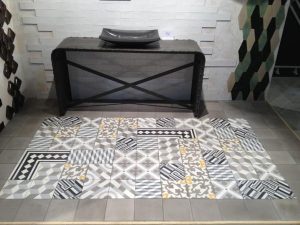Hydraulic cement tile has undoubtedly occupied one of the most prominent positions in decoration since its appearance. Indeed, since it arrived in the 19th century, it has never stopped being present. That is why as craftsmen specialized in hydraulic mosaic at Mosaics Torra, we want to tell you a little more about the hydraulic mosaic and its history.
The art of mosaic began in Assyria, passed through ancient Greece and imperial Rome, and reached our days with the artistic and material conceptions of each time.
Hydraulic Mosaic History by Periods
“The great city” of Nineveh So called in the Book of Jonah, Nineveh is where the first traces of what would later develop as mosaic art were found, with walls decorated with pieces of stone and clay.
From Greece to Rome The Roman historian Pliny the Elder gives an account of some of the most beautiful mosaics of the Hellenistic period.
One of the most famous is the one preserved in the House of the Faun in Pompeii, which depicts Alexander the Great fighting against the King of Persia, Darius III. It is made up of nearly a million and a half tesserae.
Mosaic decoration was so common in imperial Rome that every citizen with resources commissioned several for the embellishment of his residence and his villa.
The mosaic arrives in Spain The art arrived in Spain with the Romans and developed on its own after the fall of the empire.
Among the best known are The Triumph of Bacchus, discovered in Zaragoza in 1908, and The Sacrifice of Iphigenia, found in Girona in the 19th century.
Modernism With the arrival of the Modernism era, hydraulic tile begins to acquire a new prominence, to the extent that hydraulic mosaic became an artistically valuable piece, used by important designers such as Antonio Gaudí.
During this period, geometric, floral, and vegetal designs predominated, creating highly versatile compositions. Hydraulic tiles began to be designed with colorful patterns, creating very eye-catching compositions.
From the 1920s to the 1950s
Hydraulic tile began to gain significant prominence during the period from the 1920s to the 1950s. The style of hydraulic tile used during this period was characterized by neutral colors with little color, and overloaded designs with intertwined lines mainly. In the 1950s, its decline began, until it began to gain ground again in the present day.
However, its peak was in the 1960s, where the use of hydraulic tile filled the vast majority of spaces.
Hydraulic tile in the 60s
Although hydraulic tile has many more years since its origins, the truth is that in the 1960s it was one of the most used pavements in homes. In fact, it became one of the decorative trends of the time until the 1970s, and even today tiles from that time can be found in old houses.
There were various sizes of tiles, but the most common were 20 x 20. As for the most common shapes of hydraulic tiles of the time, they were formed by vegetal, geometric, and even floral designs.
The most common way to place hydraulic tile in the 1960s was as a rug, covering the entire floor, and using tiles that served to form a border around it. Contrary to what happens in modern hydraulic tile decoration, its use on walls or countertops was not common. You can find more information about these designs in the article “rugs with hydraulic tiles.”
Hydraulic mosaic today Today,
modern hydraulic cement tiles allow a multitude of combinations; times have changed, and various uses adapted to modernist decoration styles are allowed. An example of this is decoration on countertops, headboards, or walls. What is certain is that hydraulic tile remains the great protagonist of many spaces.
Torra is a Barcelona-based company that has continued the millennial culture of mosaic and tile in Spain.
The traditional manufacturing methods, combined with a variety of artistic designs, make Torra the ideal choice to enhance your home or building with high-quality and beautiful mosaics and hydraulic tiles.
Consult Torra’s technical department to plan your designs and give your residence, mall, or office an artistic touch of distinction.
Hydraulic Mosaic: Rooted in Barcelona
Talking about hydraulic mosaic and its history means talking about Barcelona. This is one of the city’s most characteristic elements. It is, in fact, a fundamental part of what has made it one of the most original and genuine cities in the world. So, talking about Barcelona is talking about hydraulic mosaic. This is due to one of the figures that will forever be associated with the city: Gaudí. Thus, it must be said that, although hydraulic mosaic initially appeared in France, it soon spread to other territories in Europe.
As it could not be otherwise, it ended up arriving in Barcelona and other cities in Spain, which we will talk about later. Its initial boom (and the one that has always accompanied it) is due to several characteristics. However, the main ones could be said to have to do with being a cheap material that gives a lot of personality. Apart from that, it has several characteristics that made it used both in the decoration of interior spaces and in the decoration of large public spaces.

How Gaudí and Others Made Hydraulic Mosaic Great
The beginnings of hydraulic mosaic soon showed the enormous possibilities it had. The first designs started with a decorative intention where geometric and floral mosaic designs abounded. They were fundamentally designed for the palace houses of the 19th century, so present in some cities in Spain such as Vitoria, Seville, or Barcelona itself. In addition, in the case of Seville, it was the protagonist of the emblematic monument of Plaza de España.
Naturally, they were also present in some cities in France or their rural populations. Thus, the initial intention was to make hydraulic mosaic an artisanal piece whose design would give the feeling of looking like a colorful rug.
It was not until later that some designers began to make their own designs. This point is important when referring to hydraulic mosaic and its history, as it explains to a large extent why this piece was so successful. As we have said, hydraulic mosaic is an artisanal work. This is because it gives us the possibility of making a totally unique design. Basically, hydraulic mosaic allows any design. That made designers dare to try their own combinations of colors, designs, and textures.
Among them, in addition to Domènech or Puig and Calafach, we must highlight the designs of Gaudí. In particular, his designs can still be found on Paseo de Gracia as well as in the Casa Milà.
Gaudí’s Imprint on the History of Hydraulic Mosaic
Gaudí is the designer who made Barcelona great. His unmistakable designs have contributed to giving the city that genuine character. Indeed, he took advantage of all the potential in terms of color and costs to give a spectacular result to the different spaces. We cannot talk about hydraulic mosaic and its history without mentioning the figure of Gaudí.
And it is that hydraulic mosaic is not only worth covering a space; beyond that, it is worth limiting it and generating differentiated environments without the need to add walls or obstacles. That makes, together with the infinite variety of different designs as well as its low cost, hydraulic mosaic has been one of the most used materials since its appearance.
So much so that along the way it has left behind other materials that have gone out of fashion: noble woods, glass, vinyl, etc. Regardless of the style that the fashion of each era marks, hydraulic mosaic fits in with all of them and continues to provide its advantages for already two centuries.
That is why we at Mosaics Torra want to invite you to discover our wide catalog. As it could not be otherwise, first of all, we have wanted to include designs from the Gaudí universe. Additionally, we have other types of designs like those of the Victorian series that will allow you to make the most of any space. Decorate with personality; with the secular and fruitful tradition of hydraulic mosaic.
The history of mosaic in Ancient Rome is that of a discipline that was generalized in villas, palaces, and thermal centers. In this article, we refer to the most common cases and explain how this technique is applied today.
History of Mosaic in Rome: Villas, Palaces, and Baths…
To determine a history of mosaic, it is convenient to say that mosaic is not of Roman origin. Although there were rudimentary techniques in Sumer, it was the Greeks who perfected it. In fact, the word mosaic comes from the Greek mousaes (muses). The occupation of Greece by Rome in the 2nd century BC meant that many masters moved to the metropolis, spreading the technique


